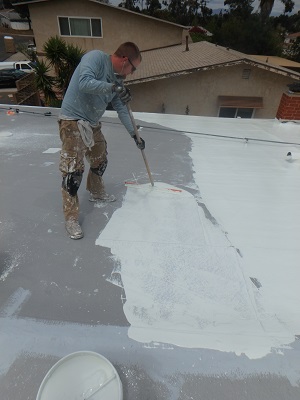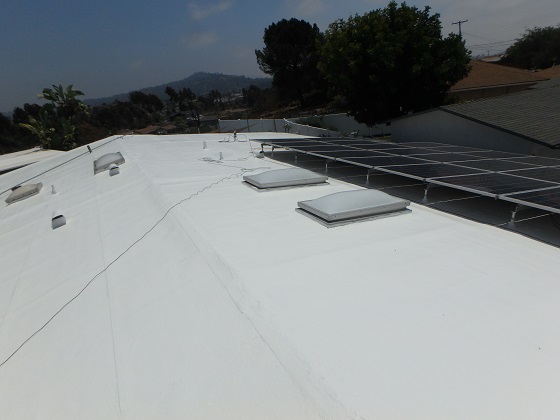Perhaps no U.S. city has weather as consistently spectacular as San Diego. With its perpetual 70 °F (21.1 °C) days and abundant sunshine, it’s no wonder that the city leads the country in installed solar energy capacity, according to the Environment California Research & Policy Center. Many San Diegan homeowners with solar panels are also likely to invest in other “green” products and services that help them save another type of green — namely, money.
This is where San Diego Roofing comes in. Established in 1936, the company has long been a trusted source of professional roofing services. According to Paul Batista, vice president for San Diego Roofing, the company used green products to complete approximately 12 to 15 projects this year. He claims that this is due to increased customer interest in green coatings, particularly over the last 10 years. “We definitely get a lot more mileage out of showcasing the product as environmentally responsible, and for a lot of the buyers out there that’s become a real forefront issue,” he said. “Now it’s more of a requirement than a bonus.”
One of those products is Ecodur 201R. Manufactured by Castagra, Ecudor 201R’s primary ingredients are castor oil and gypsum, making it one of the more environmentally friendly roof coatings on the market.
Ecodur 201R came in handy during a project San Diego Roofing worked on in early 2018. The company was contacted by a couple in San Carlos, a San Diego neighborhood, looking for a roof coating for their 3,100-square-foot (288.0 m²) home. Under normal circumstances, a project of this type could be completed in four days, said Jef McCurdy, San Diego Roofing’s director of commercial coatings. As McCurdy and his two-man crew soon discovered, though, this would hardly be a normal project.
The Easiness of Going Green
As Batista described it, the San Carlos project presented the company with some unique challenges. “Most of the homes in the area have cap sheet roofs, which have always been problematic,” he said. “And the homeowners had another element to their project: They also had solar on their roofs. So they really wanted something that would seamlessly seal in all the roofing stanchions that hold the solar panel system down.”
With the solar company having previously disconnected the roof-mounted panels, McCurdy’s team began their first day of work. But they soon realized that the carpentry company hired by the homeowners had not yet cut out their section of the roof as expected. Fortunately, McCurdy had a plan.
“As a solar owner myself, I knew the customer would not appreciate being without power for the two weeks until the carpenters completed their project,” McCurdy said. “Working with a representative from the carpentry company, we found out exactly which section of the roof they would be cutting out to complete their work and formulated a plan to complete the roof coating under and around the solar supports.”
The crew spent the rest of the afternoon using a push broom to loosen the remaining granules before blowing them away with an Echo leaf blower. Simultaneously, they worked the perimeter of the roof to ensure that no cap sheet extended over the metal drip edge so that the Ecodur 201R would be able to bond to both substrates.
One thing they didn’t need to worry about was power washing. “The main concern and challenge with roofing projects is the adherence with any coating to any substrate without power washing,” McCurdy said. “The fact that Ecodur 201R completely removes the need for power washing, and the possibility of water intrusion and water damage, makes it the only coating that I will install on someone’s house because I won’t have to introduce water to it.”
To Infinity Roof and Beyond
 The next day, McCurdy’s crew mixed fumed silica into a full kit of Ecodur 201R to create a “pancake batter-like” mastic that was used to fill in seams and penetrations. The thickened version adheres well to vertical surfaces and fills in roof gaps. As McCurdy put it, “thickening was not necessary on this project, but we do a lot of overkill for our customers.” They also used a cordless Makita drill to mix a roofing system consisting of Ecodur 201R top-coated in silicone. The company’s proprietary name for this Ecodur 201R/silicone mix is Infinity Roof, so named because it provides a seemingly infinite amount of roof protection and waterproofing capabilities.
The next day, McCurdy’s crew mixed fumed silica into a full kit of Ecodur 201R to create a “pancake batter-like” mastic that was used to fill in seams and penetrations. The thickened version adheres well to vertical surfaces and fills in roof gaps. As McCurdy put it, “thickening was not necessary on this project, but we do a lot of overkill for our customers.” They also used a cordless Makita drill to mix a roofing system consisting of Ecodur 201R top-coated in silicone. The company’s proprietary name for this Ecodur 201R/silicone mix is Infinity Roof, so named because it provides a seemingly infinite amount of roof protection and waterproofing capabilities.
McCurdy and his two installers wore protective goggles and long sleeves because even though Ecodur 201R is inert and has zero VOCs, “it sticks to everything,” McCurdy said. Aside from the double auger mixer used to prepare the Infinity Roof system, McCurdy touted the “lack of equipment needed to achieve great results.” He and his men used Dunn-Edwards chip brushes and rollers on 9-inch (22.9 cm) Shur-Line poles to apply the Infinity Roof system at 50‒60 mils (1,270.0‒1,524.0 microns) to seal any loose seams, gaps, and penetration points. Once the detail areas were completed, they mixed regular batches of Ecodur 201R and backrolled the remaining work area to an average of 30 mils (762.0 microns) in about two hours.
With the Ecodur 201R fully cured, McCurdy and his crew spent their third day on the project applying GacoFlex SeamSeal and GacoFlex S2100 to an average of 60 mils (1,524.0 microns) for an added layer of protection. McCurdy prefers using S2100 because it cleans better than other silicone-based products and works well with a basecoat of Ecodur 201R. It also has the added benefit of being composed of 37 percent recycled content, which is no small thing in San Carlos’ eco-aware community.
After applying the GacoFlex S2100 to an average of 32 wet mils (812.8 microns), leaving 1 foot (30.5 cm) of exposed Ecodur 201R as a tie-in point, McCurdy’s team did all the tasks they could on the roof until the carpenters came to finish their work. However, due to a miscommunication between the homeowners and the carpentry company, it would be yet another two weeks before San Diego Roofing could resume work on the project.
Finishing Strong
After the hiatus, the San Diego Roofing team returned to the residence and encountered another complication. Unbeknownst to them, the carpenters had slathered copious amounts of wet acrylic materials and Henry Wet Patch to the cut-out area. As a result, the coatings crew was obliged to clean off and remove the wet, damaged area. Meanwhile, McCurdy grabbed a square of bitumen, also called torch down roofing, which is rubberized asphalt known for its waterproofing qualities. The team installed the torch down in place of the cut-out area and sealed it off with a thickened kit of Ecodur 201R.
Although the clean-up and torch-down installation put McCurdy’s crew behind schedule, they were able to make good time over the project’s final two days. They treated the roof perimeter and each penetration within it with Infinity Roof and, as an added measure, applied the same base- and topcoats on penetrations.
All told, the project took 32 work hours for San Diego Roofing to complete. In recalling the San Carlos roofing project, both Batista and McCurdy reported that the homeowners were ecstatic about the results.
“They were very certain that they had picked the right company, the right project, and the right product and system to install,” Batista said.
According to McCurdy, the clientele for San Diego Roofing is highly eco-conscious. “I don’t think we had one residential customer who didn’t drive an electric car,” he claimed. But they’re not willing to compromise either.
“Customers don’t want a green product just because it’s green — it has to be green and it has to outperform the other products,” McCurdy said.
As San Diego Roofing’s customers in San Carlos and elsewhere would surely agree, that blend of environmental and economic savings from the top down is a winning combination!
